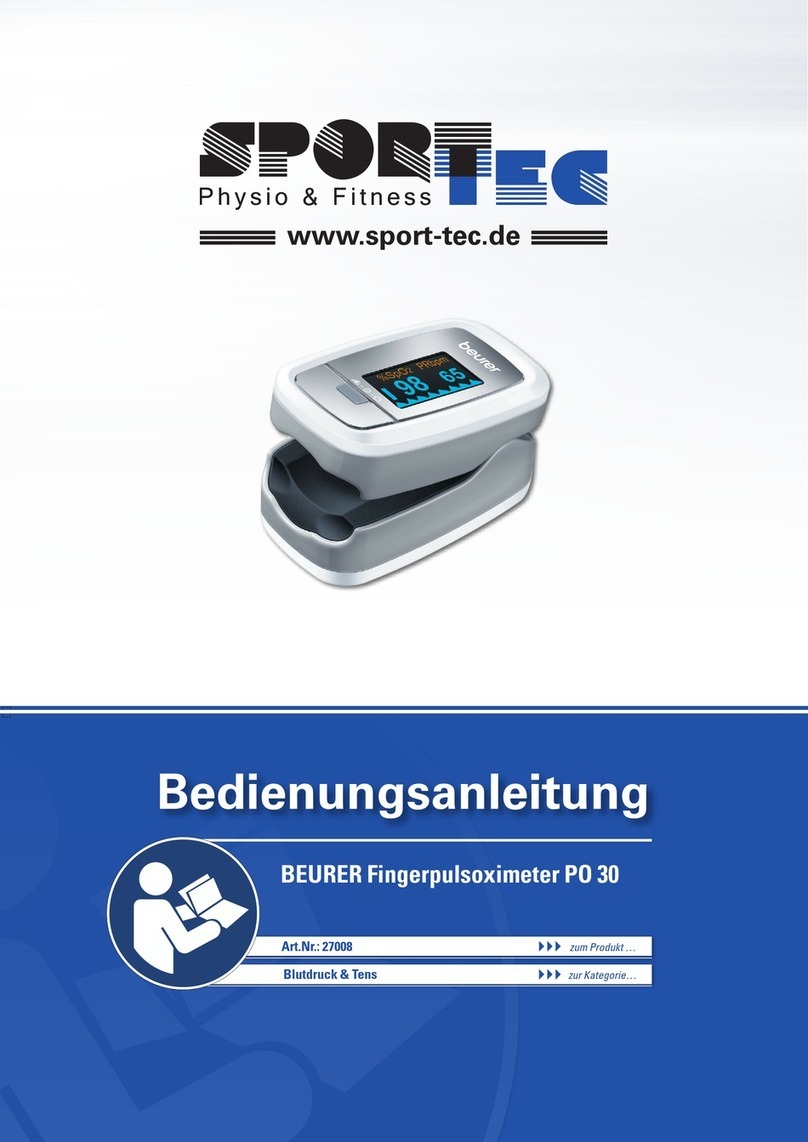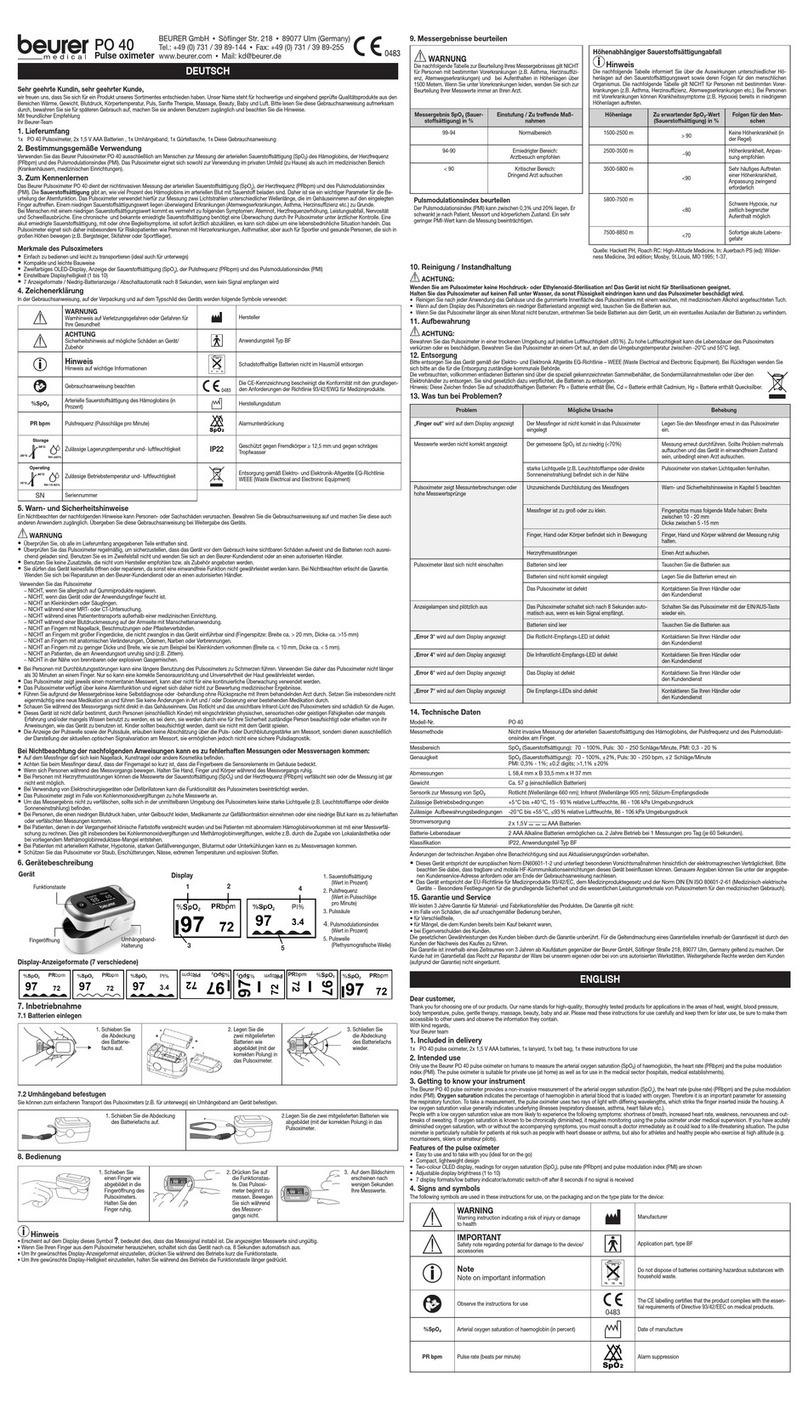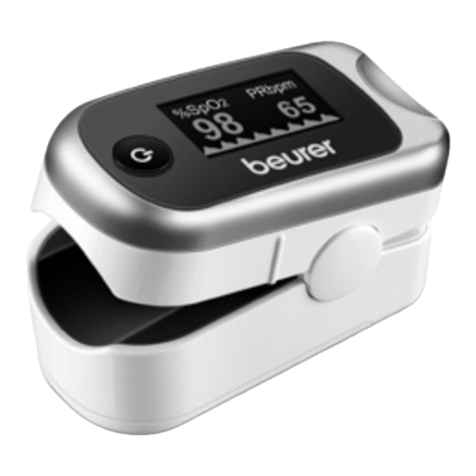751.540-0514 Subject to error and change
10. Care and Maintenance
NOTICE:
D
o not use high-pressure sterilization on the pulse oximeter!
Never expose the pulse oximeter to water.
Store the pulse oximeter in a dry place (relative humidity ≤95%). If the humidity is too high it may shorten the service life of the pulse oximeter or
damage it. Store the pulse oximeter where the temperature is between -40°F and 140°F.
•
Clean the housing and the interior rubber surface with a soft cloth dampened with isopropyl alcohol after each use.
•
If the low battery icon appears on the display of the pulse oximeter, change the batteries.
•
If you are not going to use the pulse oximeter for more than one month, remove the batteries.
11. Troubleshooting?
Problem Possible cause Solution
The pulse oximeter is not displaying
measurement values.
The batteries in the pulse oximeter are dead. Replace the batteries.
Batteries not inserted correctly. Reinsert the batteries. If after reinserting the batteries
correctly there are still no measurement values dis-
played, contact customer services.
The pulse oximeter is displaying
measurement interruptions or high
measurement value jumps.
Insucient circulation in the measurement finger. Observe the warnings and safety notes in chapter 5.
Measurement finger is too large or too small. Fingertip must have the following measurements:
Width between 0.4" and 0.9"
Thickness between 0.2" and 0.6"
Finger, hand or body is moving. Keep your finger, hand and body still during the
measurement.
Cardiac arrhythmia. Seek medical attention.
12. Technical Data
Model no. PO 30
Measurement method Non-invasive measurement of arterial oxygen saturation of hemoglobin and pulse rate in finger
Measurement range SpO 0–100%,
Pulse 0–254 beats/minute
Accuracy SpO 70–100%, ±2%,
Pulse 30–250 bpm, ± 2 beats/minute
Dimensions L 2.40 " x W 1.42 " x H 1.26 "
Weight Approx. 2 oz (including batteries)
Sensor to measure SpO Red light (wave length 660 nm); infra-red (wave length 905 nm); silicon receiver diode
Permissible operating conditions +50°F to +104°F, ≤75% relative humidity, 700–1060 hPa ambient pressure
Permissible storage conditions -40°F to +140°F, ≤95% relative humidity, 500–1060 hPa ambient pressure
Power supply 2x 1.5V AAA batteries
Battery life 2 AAA batteries last for approx. 2 years of operation at 3 measurements per day (each of 60 seconds).
Classification IP22, application part, type BF
Technical information is subject to change without notification to allow for updates.
•
This device complies with European Standard EN60601-1-2 and is subject to particular precautions with regard to electromagnetic compatibil-
ity. Please note that portable and mobile HF communication systems may interfere with this unit. More details can be requested from the stated
Customer Service address.
IMPORTANT INFORMATION REQUIRED BY THE FCC
This device complies with Part 15 of the FCC Rules. Operation is subject to the following two conditions:
(1) this device may not cause harmful interference; and
(2) this device must accept any interference received, including interference that may cause undesirable operation.
NOTE: This equipment has been tested and found to comply with the limits for a Class B digital device, pursuant to Part 15 of the FCC Rules.
These limits are designed to provide reasonable protection against harmful interference in a residential installation. This equipment generates,
uses, and can radiate radio frequency energy, and if not installed and used in accordance with the instructions, may cause harmful interference
to radio communications. However, there is no guarantee that interference will not occur in a particular installation. If this equipment does cause
harmful interference to radio or television reception, which can be determined by turning the equipment o and on, the user is encouraged to try
to correct the interference by one or more of the following measures:
• Reorient or relocate the receiving antenna.
• Increase the separation between the equipment and receiver.
• Consult the dealer or an experienced radio/TV technician for help.
Changes or modifications not expressly approved by the party responsible for compliance could void the user’s authority to operate the equip-
ment.
Electromagnetic Compatibility Information
Table 1
Guidance and manufacture’s declaration – electromagnetic emission for all EQUIPMENT and SYSTEMS
The PO30 Pulse Oximeter is tended for use in the electromagnetic environment specified below. The customer of the user of the PO30 Pulse
Oximeter should assure that it issued in such an environment.
Emission test compliance Electromagnetic environment-guidance
RF emissions CISPR 11 Group 1 The PO30 Pulse Oximeter uses RF energy only for their internal function.
Therefore, its RF emissions are very low and are not likely to cause any inter-
ference in nearby electronic equipment.
RF emissions CISPR 11 Class B The PO30 Pulse Oximeter is suitable for use in all establishments, including
domestic establishments and those directly connected to the public low-volt-
age power supply network that supplies buildings used for domestic purposes.
Harmonic emissions IEC 61000-3-2 Not applicable
Voltage fluctuations/flicker emission
IEC 61000-3-3 Not applicable
Table 2
Guidance and manufacture’s declaration – electromagnetic immunity for all EQUIPMENT and SYSTEMS
The PO30 Pulse Oximeter is intended for use in the electromagnetic environment specified specified below. The user of PO30 Pulse Oximeter
should assure that it is used in such an environment.
Immunity test IEC60601 test level Compliance level Electromagnetic environment-guidance
Electrostatic discharge (ESD) IEC 61000-4-2 ±6KV contact
±8KV air ±6KV contact
±8KV air Floors should be wood, concrete or ceramic tile. If
floor are covered with synthetic material, the relative
humidity should be at least 30%.
Power frequency (50Hz) magnetic field
IEC 61000-4-8 3 A/m 3 A/m Power frequency magnetic fields should be at levels
characteristic of a typical location in a typical com-
mercial or hospital environment
Table 3
Guidance and manufacture’s declaration – electromagnetic immunity for EQUIPMENT and SYSTEMS that are not LIFE-SUPPORTING
The PO30 Pulse Oximeter is intended for use in the electromagnetic environment specified below. The customer or the user of PO30 Pulse
Oximeter should assure that it is used in such an environment.
Immunity test IEC60601 test level Compliance
level Electromagnetic environment -guidance
Radiated RF
ICE 61000-4-3 3V/m
80MHz to 2.5GHz 3V/m
Portable and mobile RF communication equipment should be used no closer to any
part of the PO30 Pulse Oximeter, including cables, than the recommended separation
distance calculated from the equation applicable to the frequency of the transmitter.
Recommended separation distance
Where Pis the maximum output power rating of the transmitter in watts (W) according to
the transmitter manufacturer and dis the recommended separation distance in meters
(m).
Field strengths from fixed RF transmitters, as determined by an electromagnetic site
survey, ashould be less than the compliance level in each frequency rangeb
Interference may occur in the vicinity of
equipment marked with the following symbol:
NOTE 1 At 80MHz and 800MHz, the higher frequency range applies.
NOTE 2 These guidelines may not apply in all situations. Electromagnetic propagation is aected by absorption and reflection from structures,
objects and people.
a
Field strengths from fixed transmitters, such as base stations for radio (cellular/cordless) telephones and land mobile radios, amateur radio,
AM and FM radio broadcast and TV broadcast cannot be predicted theoretically with accuracy. To assess the electromagnetic environment
due to fixed RF transmitters, an electromagnetic site survey should be considered. If the measured field strength in the location in which The
PO30 Pulse Oximeter is used exceeds the applicable RF compliance level above, the PO30 Pulse Oximeter should be observed to verify
normal operation. If abnormal performance is observed, additional measures may be necessary, such as reorienting or relocating the PO30
Pulse Oximeter.
b
Over the frequency range 150 KHz to 80 MHz, field strengths should be less than 3V/m.
Table 4
Recommended separation distances between portable and mobile RF communications equipment and the PO30 Pulse Oximeter – for
EQUIPMENT or SYSTEM that are not LIFE-SUPPORTING
The PO30 Pulse Oximeter is intended for use in the electromagnetic environment in which radiated RF disturbances are controlled. The
customer or the user of the PO30 Pulse Oximeter can help prevent electromagnetic interference by maintaining a minimum distance between
portable and mobile RF communications equipment (transmitters) and the PO30Pulse Oximeter as recommended below, according to the
maximum output power of the communications equipment.
Rated maximum output
power of transmitter
(W)
Separation distance according to frequency of transmitter
(m)
150KHz to 80MHz 80MHz to 800MHz 800MHz to 2.5GHz
0.01 0.12 0.12 0.23
0.1 0.37 0.37 0.74
1 1.17 1.17 2.33
10 3.69 3.69 7.38
100 11.67 11.67 23.33
For transmitters rated at a maximum output power not listed above, the recommended separation distanced in meters (m) can be estimated
using the equation applicable to the frequency of the transmitter, where Pis the maximum output power rating of the transmitter in watts (W)
according to the transmitter manufacturer.
NOTE 1 At 80MHz and 800MHz, the separation distance for the higher frequency range applies.
NOTE 2 These guidelines may not apply in all situations. Electromagnetic propagation is aected by absorption and reflection from structures,
objects and people.
•
This device complies with the EU Directive 93/42/EC concerning medical devices, the Medizinproduktegesetz (German Medical Devices Act)
and the DIN EN ISO 9919 standard (Medical electrical equipment – Particular requirements for the basic safety and essential performance of
pulse oximeter equipment for medical use).
Made in China.
10. Nettoyage et entretien
REMARQUE:
N
’utilisez pas de stérilisation haute pression sur l’oxymètre de pouls!
Ne passez jamais l’oxymètre de pouls sous l’eau.
Conservez l’oxymètre de pouls dans un environnement sec (humidité relative de l’air ≤95%). Une humidité de l’air trop élevée peut réduire la
durée de vie de l’oxymètre de pouls ou l’endommager. Conservez l’oxymètre de pouls dans un endroit où la température ambiante se situe entre
-40°F et 140°F.
•
Après chaque utilisation, nettoyez le boîtier et la surface intérieure en caoutchouc de l’oxymètre de pouls avec un chion doux imbibé d’alcool
isopropylique.
•
Si un niveau faible des piles s’ache sur l’écran de l’oxymètre de pouls, changez les piles.
•
Si vous n’utilisez pas l’oxymètre de pouls pendant plus d’un mois, sortez les piles de l’appareil.
11. Dépannage
Problème Cause possible Solution
L’oxymètre de pouls n’ache aucune
valeur.
Les piles de l’oxymètre de pouls sont vides. Remplacez les piles.
Les piles sont mal insérées. Réinsérez-les Si aucune valeur ne s’ache même
après avoir correctement inséré les piles, contac-
tez le service client.
L’oxymètre de pouls ache des interrup-
tions de mesure ou des pics de valeur
élevés.
Circulation sanguine insusante dans le
doigt de mesure. Respecter les consignes d’avertissement et de
mise en garde au chapitre 5.
Le doigt de mesure est trop grand ou trop
petit.
La pointe du doigt doit avoir les dimensions
suivantes: largeur entre 0.4" et 0.9"
épaisseur entre 0.2" et 0.6"
Le doigt, la main ou le corps a bougé. Garder le doigt, la main et le corps immobiles
pendant la mesure.
Troubles du rythme cardiaque. Consulter un médecin.
12. Données techniques
N° du modèle PO 30
Mode de mesure Mesure non invasive de la saturation artérielle pulsée en oxygène de l’hémoglobine et pouls au doigt
Plage de mesure SpO 0–100%,
Pouls 0–254battements/minute
Précision SpO 70–100%, ±2%,
Pouls 30–250bpm, ±2battements/minute
Dimensions L 2.40 " x l 1.42 " x H 1.26 "
Poids Env. 2 oz (piles incluses)
Technique sensorielle pour la mesure
de SpO Lumière rouge (longueur d’onde 660nm); infrarouge (longueur d’onde 905nm); diode au silicium
Conditions d’utilisation applicables +50°F à +104°F, ≤ 75% d’humidité de l’air relative, 700–1060hPa de pression ambiante
Conditions de conservation applicables -40°F à +140°F, ≤ 95% d’humidité de l’air relative, 500–1060hPa de pression ambiante
Alimentation 2piles 1,5V AAA
Durée de vie des piles 2 piles AAA permettent env. 2ans de fonctionnement avec 3mesures par jour (60secondes chacune).
Classification IP22, appareil de type BF
Des modifications pourront être apportées aux caractéristiques techniques sans avis préalable à des fins d’actualisation.
•
Cet appareil est en conformité avec la norme européenne EN 60601-1-2 et répond aux exigences de sécurité spéciales relatives à la compati-
bilité électromagnétique. Veuillez noter que les systèmes de communication HF portables et mobiles peuvent interférer avec cet appareil. Pour
plus d’informations, veuillez contacter le service après-vente à l’adresse mentionnée.
EXIGENCES IMPORTANTES DE LA FCC
Cet appareil est conforme à la section 15 du règlement FCC. Son fonctionnement est soumis aux deux conditions suivantes:
(1) cet appareil ne doit pas causer d’interférences nuisibles, et
(2) cet appareil doit accepter toute autre interférence reçue, y compris les interférences pouvant entraîner un fonctionnement non désiré.
REMARQUE: Cet appareil a été testé et respecte les limitations d’un appareil numérique de classe B, conformément à la section 15 du règle-
ment FCC. Ces limitations sont destinées à fournir une protection raisonnable contre les interférences nuisibles dans une installation domestique.
Cet appareil génère et utilise un rayonnement de fréquence radio et peut causer des interférences nuisibles aux communications radio s’il n’est
pas installé ou utilisé conformément aux instructions. Il n’existe toutefois aucune garantie que de telles interférences ne se produiront pas dans
une installation particulière. Si cet appareil cause des interférences nuisibles à la réception des signaux de radio ou de télévision, ce qui peut être
déterminé en allumant et en éteignant l’appareil, l’utilisateur peut tenter de résoudre le problème de l’une des façons suivantes:
• Réorienter ou déplacer l’antenne de réception.
• Éloigner l’appareil du récepteur.
• Demander conseil au fournisseur ou à un technicien radio/TV expérimenté.
Toute transformation ou modification non expressément autorisée par la partie responsable de la conformité pourrait faire perdre à l’utilisateur
son droit à utiliser cet équipement.
Fabriqué en Chine.






















